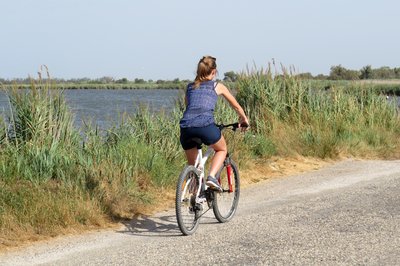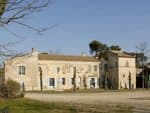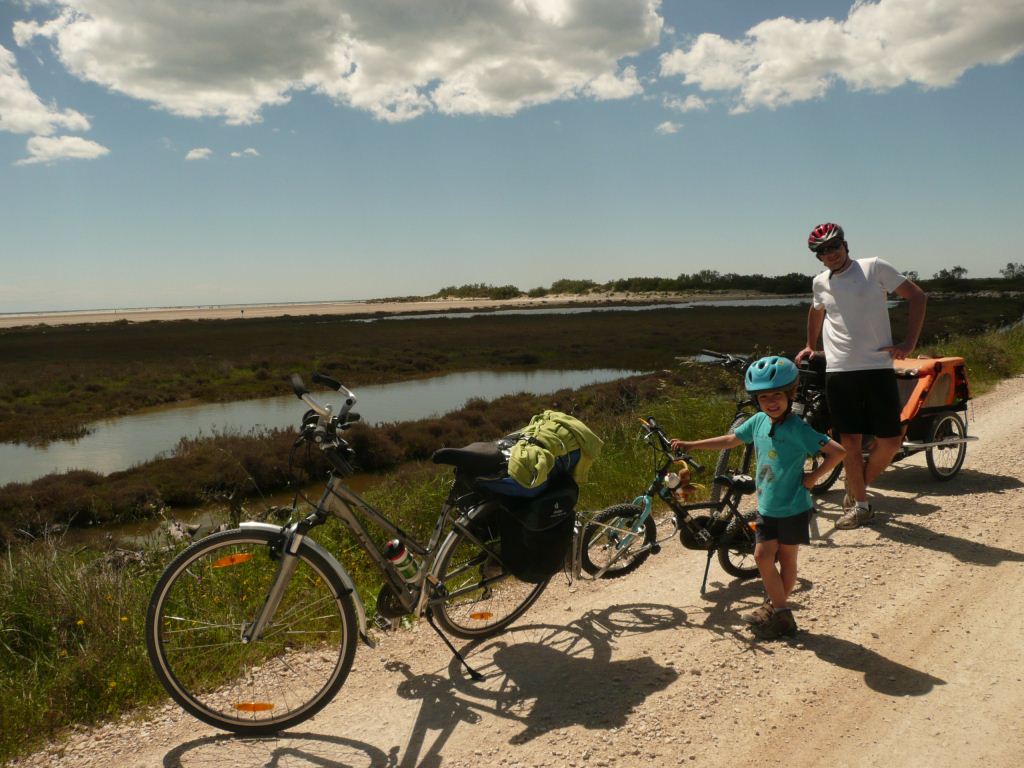
Go qround Vaccarès in 2 days by bike
Cycling along the largest pond in Camargue, is to discover many migratory birds, flamingos, horses but it is also to walk paths with unique vegetation. It is sometimes necessary to listen, to scrutinize the horizon for a few minutes to see the emblematic species of this preserved place. A perfect combination to enjoy remarkable views of the pond and to admire the rich diversity of fauna and flora of Camargue!
2 steps
20 points of interest

Les cloches de l'église - Chloé Scannapiéco - PNR Camargue  Panorama
PanoramaThe fortified church of Saintes-Maries-de-la-Mer
True highlight of the Camargue (15 m), the church offers a breathtaking view of the village and all the Camargue. The 53 steps of a spiral staircase lead to the roof of the church where the panorama unfolds in all its splendour : up there, you can take advantage of a wide angle vision on the city, the sea and the ponds. Intense and sparkling blue of the Mediterranean Sea, purple hue of the Imperial pond The wind, the sun, the view of the calm expanse of the sea invite you to discover this landscape.

Anguille sortie du filet - Julien Faure - PNR Camargue  Fauna
FaunaThe eel
At the graus level (or passages), communication canals between the sea and the littoral ponds, you will find fish, towards the flooded sansouïre and the ponds or towards the sea. Migrating species include mullet, sea bass, but also sea bream, sole and especially eel. Born in the Sargasso Sea, she joined the Atlantic and Mediterranean coasts after a long journey. She comes to grow in the coastal ponds or rivers where she spends several years of her life.
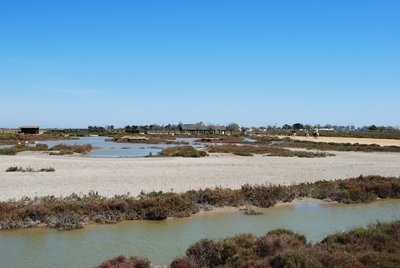
Le long de la draille de Méjanes - Chloé Scannapiéco - PNR Camargue  Panorama
PanoramaThe Departmental Reserve of Imperialists
Classified Departmental Reserve, Imperial and Malagroy Ponds were acquired by the Departmental Council of Bouches-du-Rhone in 1964 to protect these fragile natural environments (2,770 ha) which are home to many species of birds. The fishing, a traditional activity in Camargue, is practiced in the Imperial reserve in a boat without motor which imposes the use, as formerly, of the "partygue" (pole). Fishermen are looking for shrimps, eels.
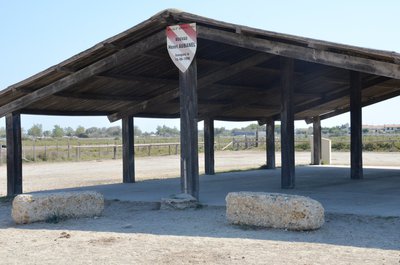
Juliette Primpier - PNR Camargue  Patrimony and history
Patrimony and historyLe Bouvau d’Aubanel
The Baroncelli marquis, famous character of Camargue life, gave to his manade the name of Manade Santenco which means, in Provençal, manade of Saintes-Maries. At the death of the marquis, his son-in-law Henri Aubanel then manages the Santenco manade.. On June 15, 1996, the Saintes-Maries-de-la-Mer inaugurate the Henri Aubanel bouvau, a circular enclosure where bulls are grouped after selection. At the death of Henri Aubanel, his son Pierre manages the manade that he renames Aubanel Baroncelli Santenco manade.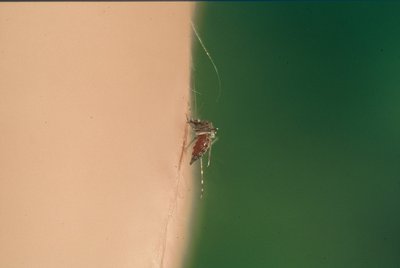
Moustique - Emmanuel Vialet - PNR Camargue  Fauna
FaunaThe Mosquito
There are 40 species of mosquitoes but only ten are biting. Females recover protein from the human blood that are necessary for the maturation of their eggs. They lay thousands of eggs on the soil dried up that are waiting, sometimes years, the rise of the waters to hatch. The mosquito is inconvenient for the man but it is useful to many species: dragonflies, fish, bats ... that feed on them. It is therefore an indispensable link in the Camargue biodiversity.
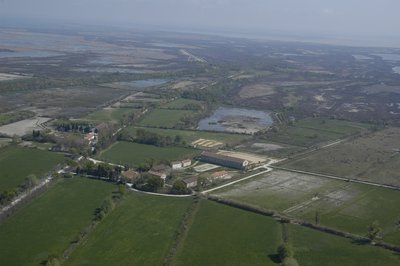
Opus Species - PNR Camargue  Water and rivers
Water and riversThe Consécanière pond
It is a place of passage and rest for many migratory birds In winter, ducks and coots find a relative tranquillity. This natural abundance motivated the need for protection by the Department of Bouches-du-Rhône as well as the Malagroy and Imperial ponds. The water level of the Consécanière pond is maintained artificially low by pumping, the pump rejecting the waters of the pond towards the Malagroy pond. The pond is surrounded by a wooded border of tamarisk.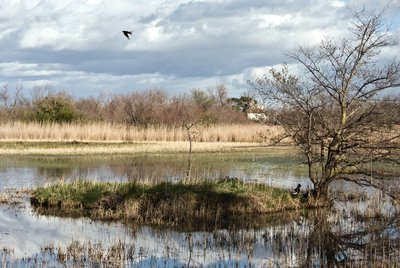
La Réserve de Camargue avec la Capelière au loin - ©Guillaume Caffier - PNR Camargue  Panorama
PanoramaThe Camargue National Nature Reserve
The Camargue National Reserve was created in 1927 by the National Society for Nature Protection (association) to protect animal and plant species. True heart of the Camargue, the Reserve covers 13,117ha, much of which is formed by the Vaccarès pond. The reserve offers many accomodation possibilities and tours: the Capelière, Salin-de-Badon and the lighthouse of Gacholle. The Capelière is the welcome point of the Reserve. You will find exhibitions, documentation, discovery trails. Entry authorizations for the observatories in Salin-de-Badon are issued at La Capelière.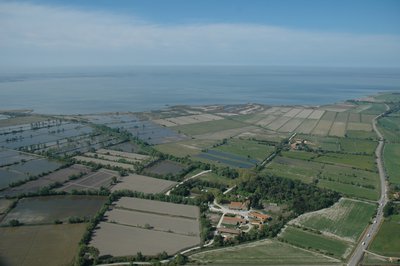
Grand Romieu, Mas Saint-Germain et Vaccarès - ©Opus Species - PNR Camargue  Panorama
PanoramaCultivated environments
The Camargue is both an extensive breeding ground (bulls and horses) but also a field crop area (rice and wheat). Cereal and oilseed crop growing areas occupy the uplands. The strong natural constraints that weigh on these productions require important investments in terms of irrigation and drainage. On the other hand, extensive rangeland systems are spread over natural environments (pastures, reed beds, marshes).
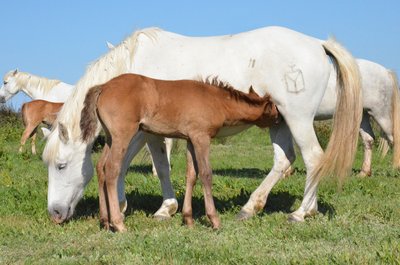
Cheval de Camargue et son poulain - ©Marjorie Mercier - PNR Camargue  Elevage et pastoralisme
Elevage et pastoralismeThe Camargue Horse
The Camargue horse is a very old breed (1978) and would descend from the prehistoric horse of Solutré. Symbol of the Camargue, with a gray-white dress, short ears and a shaggy mane, it is small, about 1.45 m at the withers. His dark hair of birth takes its final colour white-gray when he is around 4 years old. Raised in the Camargue, he is the companion of the guardian and the working tool for raising bulls. Breeding and reproduction criteria are strict to preserve his breed.
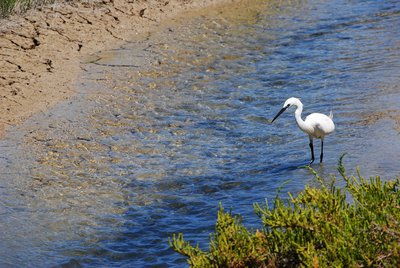
Aigrette garzette - Chloé Scannapiéco - PNR Camargue  Fauna
FaunaThe Little Egret
The Little Egret is one of the most famous birds in the Camargue. White plumage, black legs and yellowish fingers make it easily identifiable. In nuptial plumage, the neck of adults is adorned with two hoopoes about twenty centimeters and their back long silky feathers very thin with separate beards. Today widespread in the southern half of Europe, this species was on the verge of extinction in the early twentieth century, hunted for its feathers that decorated the hats.

Fleurs de saladelle - Chloé Scannapiéco - PNR Camargue  Flora
FloraThe sea lavender
Named "lilac" or "sea lavender", because of its beautiful purple flowers, the saladelle is a plant of the Mediterranean shores which lines the lawns, it is an edible plant. Abundant in the land salted, the sea lavender has long fleshy leaves that we can observe for a long period of the year. This plant is salt tolerant. Excess from the soil is rejected in fine crystals by pores on the underside of the leaves on the underside of its leathery leaves.

Phare de la Gacholle - Chloé Scannapiéco - PNR Camargue  Patrimony and history
Patrimony and historyThe Gacholle lighthouse
Located at 1500m inland, the Gacholle lighthouse entered service in 1884. It allows access to the anchorage of the Beauduc Gulf whilst avoiding the dangers of the tip of Sablon. 17m high, it is powered by solar panels and is distinguished by its sector lighting in green, white and red. The Gacholle lighthouse is one of the welcoming points of the Camargue Nature Reserve. An exhibition on the Camargue coast is open on weekends and public holidays and during school holidays from 11:00 - 17:00 / 11am - 5pm, free admission. Two other lighthouses were built: Beauduc Lighthouse (1903) and Faraman lighthouse (1840).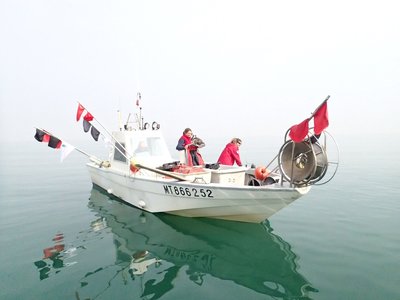
Pêches scientifiques dans la réserve marine - Delphine Marobin-Louche - PNR Camargue  Fauna
FaunaMarine Reserve
The fishing lodgings of the Beauduc Gulf was established in 2013. The goal was to restore this nursery area for fish by creating a "safe area". Covering an area of 450ha and located 700m from the shore, the area is forbidden to all types of fishing, anchorage, dragging and diving. 6 yellow markings enables mark this area at sea. Scientific monitoring is carried out in partnership with fishermen and all the actors of the marine world. The surveillance of the sea and awareness are carried out by officers of the Park.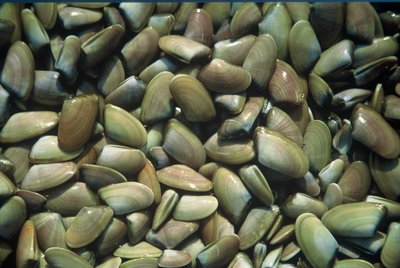
Les tellines - Emmanuel Vialet - PNR Camargue  Fauna
FaunaTellin
Tellin is a small shell that lives buried a few centimetres on coastal sand, close to the shore. Its colour varies from brown to lemon yellow, through a salmon pink. It takes its name from its two valves spread like butterfly wings when it's washed-up and stranded. In the morning, the tellin shell gatherers collect this bivalve using a small trawling net shaped like a fishing net rake. The exploitation of this resource is subject to licensing in the Camargue. Amateur fishermen, anglers, respect the resource and the instructions (1.5kg / day / person. ; min. size: 2.5cm).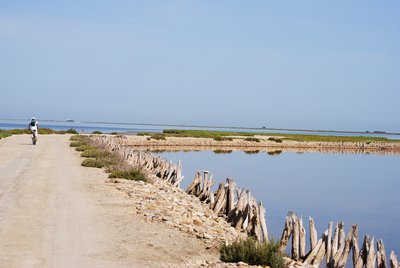
Sur la digue à la mer - Chloé Scannapiéco - PNR Camargue  Water and rivers
Water and riversThe sea wall
During the 19th century, Camargue has faced frequent floods, causing considerable damage. Thus, the sea wall was built between 1857 and 1859 to protect Camargue from sea ingression onto the land during fall and winter which stop any agricultural development in southern Camargue. 2m to 2.50m high, this structure extends over a length of over 40km. It separates the lagoons from the central ponds of Camargue, forming a visual boundary in an infinite landscape.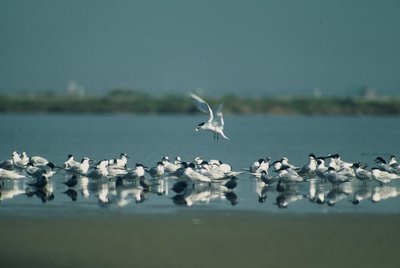
Sternes caugek - Emmanuel Vialet - PNR Camargue  Fauna
FaunaThe Sandwich tern
Terns are long-distance migratory birds which travel thousands of kilometres during their travels. Their final destination is West Africa. The sandwich tern is characterized by a fully black head with a shaggy crest on the neck, a long slightly curved black and yellow beak, an ash gray slender body and long wings. This migratory species, especially present in the sea and lagoons, is observable during the breeding season (spring/summer).
Dunes et oyats - Chloé Scannapiéco - PNR Camargue  Panorama
PanoramaThe beach and dunes
Sandy, Camargue beaches extend on about 70km. The coastal dunes which make up the setting are of great landscape and botanical value with a specific flora and rare species of insects. These animal and plant species which have adjusted to the sandy soil, to drought and salt, live in the dunes (lizards, sand lilies, dune grass ...). Rich but fragile, so be careful when you pass not to uproot the dune grass that are hanging on. Accessing the dunes is strictly prohibited, even on foot.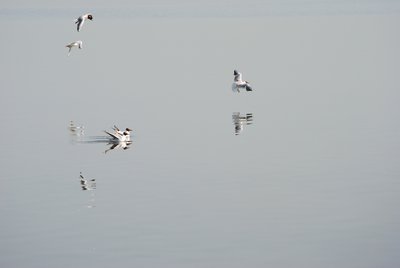
Mouettes rieuses - Chloé Scannapiéco - PNR Camargue  Fauna
FaunaThe black-headed gull
The feathers of the black-headed gull is white on the entire body, except for its which are gray and black in the ends, from August to December. The adult is recognizable by the dark spots behind the eyes. Its white head sports a breeding plumage of chocolate colour. Its short beak, sharp and pointed, is red and black at the tip, as its legs and fingers. Its diet consists of insects, worms, crustaceans but also plants and household waste.
Étangs et marais salants - Elen Le Roux - PNR Camargue  Panorama
PanoramaPonds and salt marshes
Located in the lower Camargue, shallow ponds are separated from the sea by a sand bar. With intermittent communication with the sea through the valves, these lakes are brackish or salty. Privileged shelters for birds and fishes, they also play an important role in water management. Because of their stretch and the richness in invertebrates, they are areas appreciated by birds, including the Greater flamingo.
Pertuis de Rousty - PNR Camargue  Water and rivers
Water and riversHydraulic structures
Camargue is a place of constant exchanges between the sea and the ponds. To regulate the exchanges between these two environments, three openings (or valves) have been positioned along the sea wall. The Fourcade opening is the only functional exchange zone, continuous between the ponds and the sea. It allows the flow of water and fishes and plays a major role for migratory exchanges, wildlife, salt and water levels, fishing, fish rearing and flood management.
Description
Back to the Tourist Office on Van Gogh Avenue, head right. At the roundabout, take the second exit and cross the village towards the Cacharel road for 4 km.
1 - Around the small parking, before the Cacharel farmhouse, take the track of the Five Gorges (said Méjanes) on the right. Continue for 11 km to the Méjanes estate.
2 - After the Méjanes estate, at the sign "give way", go right on the D37 and continue for 8 km. Go along the Vaccarès pond. Pass in front of the observation point of Mas Neuf Vaccarès (set up by the Camargue Regional Nature Park). After the observatory, continue towards Arles and Salin-de-Giraud.
3 - At the intersection of Villeneuve and the snack bar Les Salicornes, turn right on the C134 "Fiélouse" towards La Capelière. Cycle there for 14.5 km. Go along the pond Pass in front of La Capelière, Mas de Fiélouse, then Salin-de-Badon.
4 - Continue straight towards the dike to the sea. Continue on the trail to the Flamingo Observatory.
5 - At the observatory, turn right and take the dike to the sea towards the Gacholle lighthouse (trail accessible only on foot and by bike). Enter the Camargue National Nature Reserve. Pass the lighthouse and continue. Continue on the dike to the sea until Pertuis de Rousty. At Pertuis, continue straight to the village of Saintes-Maries-de-la-Mer which is located 6 km from there.
- Departure : Tourist Office, les Saintes-Maries-de-la-Mer
- Arrival : Les Saintes-Maries-de-la-Mer
- Towns crossed : Saintes-Maries-de-la-Mer and Arles
Forecast
Altimetric profile
Recommandations
Respect the rules of the road on roads open to public traffic.
Stay alert on the D37, dangerous and busy road!
The itinerary being done in 2 days, think to reserve an accommodation according to the distance to be crossed the first day. Contact the tourist offices of Saintes-Maries-de-la-Mer and Salin-de-Giraud.
Several starting points are recommended: The Saintes-Maries-de-la-Mer, the Domaine de Méjanes or Salin-de-Giraud.
Park your car in a secure location.
At La Capelière, you will find the information point of the Camargue National Reserve.
Information desks
the Camargue museum
Mas du pont de rousty, 13200 Arles
Remember to visit the Camargue museum! It is located next to the administrative centre of the Camargue Nature Park.
OT Saintes-Maries-de-la-Mer - Tourisme en Camargue
5 Avenue Van Gogh, 13460 Saintes Maries de la Mer
Transport
Envia transport network : Ligne 20 > Arles/Les Saintes-Maries-de-la-Mer byAlbaron (free bike racks) or Agglo 10 > Arles/Salin-de-Giraud by Gageron et Villeneuve >> www.tout-envia.com; Www.pacamobilite.fr
Access and parking
37 km south-west of Arles, by the D570.
Parking :
Access
- Emergency number :
- 114
More information
Report a problem or an error
If you have found an error on this page or if you have noticed any problems during your hike, please report them to us here:

